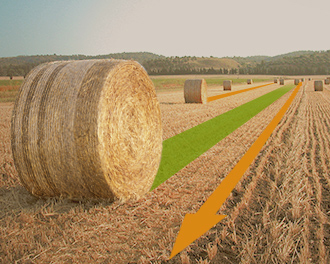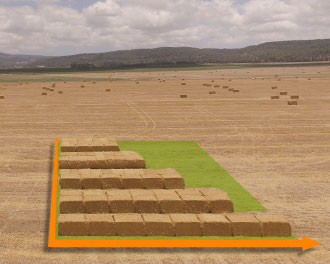Netwrap Best Practice: Top Tips for Better Baling
2025
Netwrap is one of the unsung heroes of modern round baling. It might look simple, but how it’s applied and… Read more
Netwrap is one of the unsung heroes of modern round baling. It might look simple, but how it’s applied and the way you manage your baler and wrap, has a huge impact on bale quality, storage life, and efficiency.
Get it right, and you’ll save time, reduce waste, and protect the value of your forage. Get it wrong, and you risk loose, misshapen bales that don’t stack well and spoil more quickly.
In this article, we’ll cover best practices and top tips for using netwrap effectively, so you get consistent, reliable results from every bale.
- Choose the Right Netwrap for the Job
Not all netwraps are created equal. Using the correct product for your baler and crop type is the first step to success.
- Length and roll size: Make sure the roll matches your baler’s recommended specifications. Too wide or narrow can cause feeding issues.
- Strength: While straw is lighter than silage, it is also more “explosive” when baled and handled, so strength is still critically important across all crop types. Choose a high quality netwrap designed to cope with these demands.
- UV protection: If bales are stored outside, UV-stabilised netwrap prevents premature breakdown.
Using a reputable brand ensures consistent roll length, width, and tear strength, which reduces stoppages and frustration in the field.
- Correct Loading and routing
One of the most common causes of netwrap issues is incorrect routing. Even a small mistake can cause poor coverage, uneven wrapping, or net jams.
- Follow the manufacturer’s diagram inside your baler carefully, paths vary between models.
- Check rollers and guide bars for dirt, corrosion, crop residue, or worn bearings. Clean and replace as needed.
- Keep tension correct too loose, and the net won’t spread; too tight, and it risks tearing.
Tip: After loading a new roll, run a test bale to make sure everything is feeding smoothly before starting full-scale baling.
- Aim for Full Edge-to-Edge Coverage
Proper coverage is essential for bale stability, storage, and weather resistance.
- Edge-to-edge netwrap is designed to cover the full width of the bale, protecting shoulders and reducing spoilage.
- For the best-looking bales and the most consistent silage quality, always use a netwrap that delivers reliable, consistent edge-to-edge coverage.
- Overlap beyond the edge can waste net and cause handling problems, so keep settings calibrated.
- Apply the Right Number of layers
Using too few layers risks the bale falling apart. Using too much wastes time and money. The right number depends on:
- Crop type: Straw often requires more net than silage because it is explosive, frequently handled, and prone to bursting. Silage, by comparison, tends to need fewer layers.
- Storage plans: Bales destined for long-term storage or outdoor stacking may need an extra half to one layers of net.
- Baler density settings: Less dense bales may need fewer layers, while denser bales often require more to keep their shape during handling.
Rule of thumb: 2-2.5 layers for Silage, 2.5 to 3+ for Hay and straw. But check your baler and netwrap manufacturer’s guidelines.
- Keep Blades Sharp and Clean
A blunt or dirty net knife is one of the main causes of wrapping failures.
- Inspect and sharpen (or replace) blades regularly.
- Clean off sap, dirt, and crop residues that reduce cutting efficiency.
- Check that knives are making a clean even cut across the full width of the net.
A poorly cut net can cause tails to wrap around rollers, leading to downtime in the field.
- Store Netwrap Properly
Netwrap is durable in use, but poor storage can ruin it before it ever gets near the baler.
- Rolls should be stored horizontal, this is how they are delivered and commonly kept on-farm.
- Keep them away from direct sunlight, moisture, and rodents.
- Always store under cover to protect quality.
Tip: Always rotate stock; use last year’s rolls first to maintain quality.
- Maintain the Baler’s tying system
Even the best netwrap won’t work properly if the baler isn’t in good condition.
- Roller condition: Replace worn, misshapen or scored rollers.
- Belts and tensioners: Check for even wear and correct adjustment.
- Sensors and electronics: Ensure bale size sensors and layer counters are calibrated.
Preseason checks are vital to avoid breakdowns mid-harvest.
- Monitor Bale Quality in the Field
Don’t assume everything is working perfectly once you start baling, check your results regularly.
- Inspect the first few bales of each job for even coverage, edge protection, and tightness.
- Watch for tails of net left loose, this usually indicates knife or tension issues.
- Adjust wrap settings if moving between crop types or moisture conditions.
- Think About Efficiency
Time spent tying is time not baling. Choosing the right netwrap and settings can improve efficiency significantly.
- High-quality netwrap spreads quickly and evenly, reducing baler stoppages.
- Fewer revolutions to achieve full coverage means faster baling and less fuel.
- Reliable performance reduces downtime caused by re-baling or machine stoppages.
Conclusion: Small Details, Big Results
Netwrap might feel like a minor part of your baling operation, but it’s the detail that protects the value of every bale you make. By following these best practices, from choosing the right wrap, to keeping knives sharp, to checking bale quality in the field; you’ll reduce waste, improve efficiency, and get more from every roll of wrap.
Remember: in baling, consistency is everything. A small adjustment in how you handle your netwrap can make a big difference across thousands of bales in a season.



